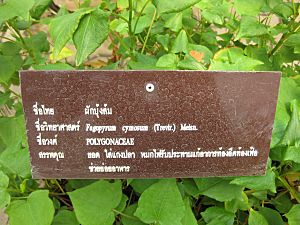Fagopyrum tibeticum facts for kids
Quick facts for kids Fagopyrum tibeticum |
|
|---|---|
 |
|
| Scientific classification | |
| Synonyms | |
|
Fagopyrum tibeticum is a special type of plant known as a woody buckwheat. It belongs to the Polygonaceae family, which includes many well-known plants like rhubarb and knotweed. This unique plant is found only in one specific part of the world.
What is Woody Buckwheat?
Most buckwheat plants are small and grow for only one year. They are often used to make flour for pancakes or noodles. However, Fagopyrum tibeticum is different. It's called a "woody" buckwheat because it has stems that are harder and more like wood than typical buckwheat plants. This makes it quite unusual among its relatives.
Where Does It Grow?
This special plant lives in a very unique place: the Qinghai-Tibetan Plateau. This plateau is a huge, high-altitude area in Asia, often called the "Roof of the World." It has a harsh climate with cold temperatures and strong winds. Plants that grow here, like Fagopyrum tibeticum, have adapted to survive these tough conditions. Because it's only found in this region, it's considered an endemic species, meaning it naturally lives nowhere else.
Why is it Important?
Scientists are very interested in Fagopyrum tibeticum because it can help them understand how plants evolve and adapt to extreme environments. Studying its unique woody features and its origins on the Qinghai-Tibetan Plateau gives clues about plant survival. It also helps us learn more about the diversity of the buckwheat family.

